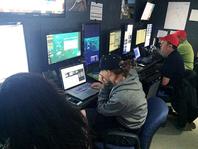IISE Transactions publishes GROUPER Lab paper
PhD student Jordan Hill authored the paper titled "Remote Physiological Monitoring in a Mars Analog Field Setting". Co-authors are Prof. Barrett Caldwell, NASA Biologic Analog Science Associated with Lava Terrains (BASALT) research program Principal Investigator Darlene S.S. Lim, and Michael Downs and Michael J. Miller of Kennedy Space Center.
ABSTRACT
The ability to monitor physiological parameters of individuals remotely while they work or live in an extreme environment is useful for promoting health and safety. There is limited demonstration of real-time, remote ambulatory physiological monitoring during field science tasks with readily available, Commercial-Off-The-Shelf, or COTS, products. In order to investigate physiological responses to tasks approximating those that will be performed during planetary exploration, the Zephyr BioHarnessTM was integrated into NASA’s BASALT Mars Analog field deployment for real-time, remote extravehicular crew monitoring during field traverses and sample collection tasks at the Craters of the Moon National Monument in Idaho, and Hawai’i Volcanoes National Park. This opportunity was leveraged to assess the feasibility of using COTS physiological monitors to stream live data and develop protocols for real-time health status determination under remote networking conditions in a field geology setting. Physiological monitoring data was transmitted from a field setting to a remote monitoring site at a resolution of 1 Hz in 23 out of 28 simulated EVAs. Outages were generally attributed to the difficulties of implementing a field network in an environment such as the ones in which BASALT operated rather than inherent issues with the COTS instrumentation. Conclusions were drawn that this application of COTS physiological monitoring is potentially applicable to a range of field research tasks, and requires detailed understanding of tasks and individuals when determining health status and performance limits.


